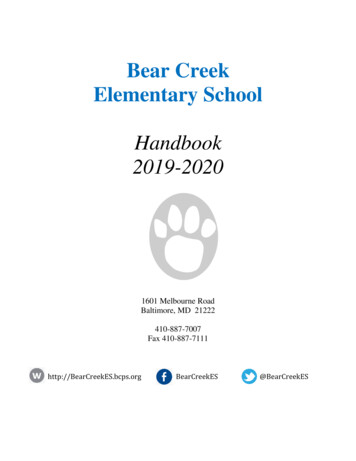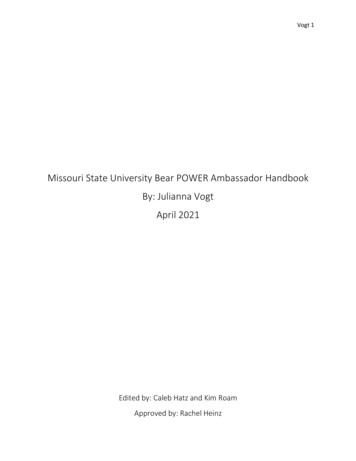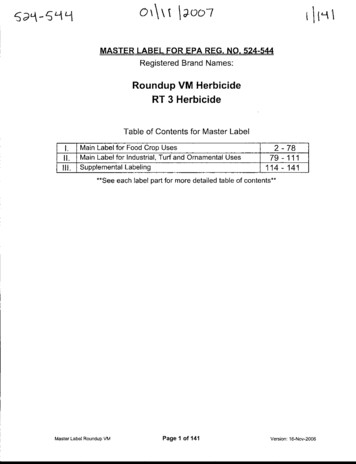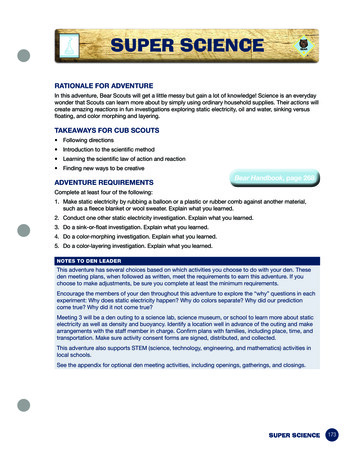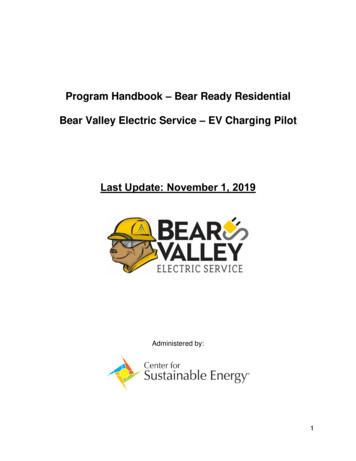
Transcription
Program Handbook – Bear Ready ResidentialBear Valley Electric Service – EV Charging PilotLast Update: November 1, 2019Administered by:1
This page intentionally blank.2
Table of ContentsProgram Handbook for Bear Valley Electric Service – EV Charging PilotA. INTRODUCTION . 41. Bear Ready Residential Program Overview . 5B. Residential Make-Ready Eligibility . 51. Customer Type and Size . 52. Site Requirements . 6C. APPLICANT DUTIES AND REQUIREMENTS . 61. Application Stage . 62. Participation Stage . 7D. APPLICATION PROCESS . 71. Application and Installation Process . 7E. DEFINITIONS . 83
A. INTRODUCTIONIn March 2012, Governor Edmund G. Brown Jr issued an Executive Order B-16-2012 tohelp accelerate the market for zero-emission vehicles (ZEVs) in California and set along-term goal of reaching 1.5 million zero emission vehicles on California’s roadwaysby 2025. The executive order established milestones for three periods: By 2015, California’s major metropolitan areas will be able to accommodate zeroemission vehicles through infrastructure plans. By 2020, California’s zero emission vehicle infrastructure will be able to supportup to 1 million vehicles. By 2025, 1.5 million zero emission vehicles will be on California’s roadways witheasy access to infrastructure.These milestones require mechanisms to install electric vehicle (EV) charginginfrastructure quickly and effectively.On October 7, 2015, Senate Bill (SB) 350, the Clean Energy and Pollution ReductionAct (Chapter 547, Statutes of 2015), was signed into law, establishing new cleanenergy, clean air and greenhouse gas reduction goals for 2030 and beyond. Amongother things, SB 350 requires the California Public Utilities Commission (Commission),in consultation with the California Air Resources Board (CARB) and the CaliforniaEnergy Commission (CEC), to direct the utilities to undertake transportationelectrification (TE) activities consistent with Public Utilities Code Sections (Pub. Util.Code §§) 237.5 and 740.12.1.September 27, 2018 the Commission adopted the Settlement Agreement (ApplicationNo. 17-06-034) for Bear Valley Electric Service (A Division of Golden State Water)(hereinafter, BVES) Make-Ready Pilot.Bear Ready Residential is BVES residential EV charging pilot program intended toencourage and accelerate easy access to residential home charging for Big Bearresidents while also supporting the best interest of Bear Valley Electric Servicesratepayers. Under Bear Ready Residential, BVES will reimburse eligible residents forthe installation of the electrical infrastructure needed for electric vehicle (EV) charging atparticipating Big Bear residential locations. Local residents will need to select anapproved contractor to install electrical infrastructure, meeting minimum programrequirements, for EV charging at their site, and participate in the TOU-EV-1 rate.This Bear Ready Residential Program Handbook (Program Handbook) details eligibility,program requirements and provides necessary definitions, explanations, and processesassociated with the program requirements for residential properties. The ProgramHandbook may be periodically updated as needed to clarify project requirements andimprove program effectiveness. The Program Handbook, including any updates, will beposted on the Bear Valley Electric Service webpage ments/BVES Bear Ready Residential Program Handbook.pdf4
Note to Applicants: At the time an applicant submits a signed application for programparticipation, the most current Program Handbook available, as well as the ProjectRequirements signed by the applicant, will apply.This document constitutes the Program Handbook for Bear Ready Residential.Definitions of key program parameters are in Section E of this manual.1.Bear Ready Residential Program OverviewThrough Bear Ready Residential, local Big Bear residents can apply to have BVESreimburse them for the cost of the design, permit, and installation of the electricalinfrastructure to support up to one (1) Level 2 EV charger at their residence. Allresidential EV charger installations will be required to add a submeter to an existingBVES customer residential location. BVES will reimburse the residential participant forthe equipment and electrical contractor labor required to add the submeter. Participatingresidents may use their preferred EV charger on the electrical infrastructure.Eligible residents must have a current active BVES electric account supplying electricityto the residential location listed on the application.Following installation, participating home owners and/or residents will need to keep theelectrical infrastructure in place for at least 10 years. All participating residents will havetheir EV chargers enrolled in the residential Time of Use Electric Vehicle Charging(TOU-EV) pilot rate designed to both minimize the impact to the local electrical grid,while encouraging residential EV chargers.Potential applicants can determine their eligibility through review of Section B of thisProgram Handbook, and by contacting the Center for Sustainable Energy (CSE) directlyby email at BearReady@energycenter.org or by calling (800) 808-2837. Once anapplication is screened and approved, applicants will be notified of their selection byBVES.Information about Bear Ready Residential is also available to the public and otherinterested parties via the BVES webpage. The BVES dential, is operated and maintained by BVES, and includes an up-to-date listof eligible equipment models, participating electrical contractors, program applications,and all supporting documentation and forms applicable to the Bear Ready Residentialprogram.B. Residential Make-Ready Eligibility1.a.Customer Type and SizeMust be a single-family dwelling concurrently served under a Domestic (D and5
DO) schedule.b.2.Be the property owner to apply on behalf of a qualified site.Site RequirementsSites must meet the requirements listed below to be eligible for participation in BearReady Residential.a.Be located within and served electricity by Bear Valley Electric Service. Serviceaddress will be required during application process and CSE can terminateapplications that do not meet required address validations.b.Comply with all federal, state and municipal laws, ordinances, rules, codes,standards and regulations.c.Have off-street parking serving the main use of the site. The off-street parkingmust be reasonably accessible from a point of power connection.d.Be available to move forward in the Bear Ready Residential program within areasonable timeframe, if selected for participation.C. APPLICANT DUTIES AND REQUIREMENTS1.Application Stagea.Submit a complete Preliminary Service Request (PSR) to BVES.b.Submit a complete application including all required documentation forparticipation in Bear Ready Residential before program funds are exhausted.c.Indicate parking space, meeting the site requirements, that is available forparticipation in Bear Ready Residential. Dedicate one space per EV chargerconnector.d.Select an electrical contractor from the list of approved Big Bear approvedcontractors. Request and submit the contractor quote for the make-ready designto BVES.e.After the quote is approved from BVES, then have the contractor begin the job.f.If selected for participation in Bear Ready Residential, complete enrollment in the6
TOU-EV rate.2.Participation Stagea.Allow random inspections of the make-ready infrastructure.b.Participate in ongoing research efforts to support the Bear Ready Residentialpilot program. Participation may include phone interviews, focus groups, and / orsurveys to gather information on aspects of the Bear Ready Residential programand EV driver response to the program.The applicant is responsible for ensuring the accuracy of the information on theirapplication and required documentation submitted to CSE. The applicant is alsoresponsible for using the Bear Ready Residential infrastructure solely for EV chargingfor the duration of the program. The use of the infrastructure for anything other than EVcharging will void participation in the TOU-EVI-1 rate, and accumulated usage will beback billed at the house meter rate and any extra charges will apply. The applicant mayalso be required to repay the reimbursement costs incurred by BVES.D. APPLICATION PROCESS1.Application and Installation ProcessTo apply for participation in the Bear Ready Residential pilot project, applicants canfollow this simple process:a.Send in an interest email or for preliminary eligibility review.1. Email your name, service address, and interest in Bear ReadyResidential to BearReady@energycenter.org or mail a letter to: Centerfor Sustainable Energy, Attn: Bear Ready Residential, 3980 ShermanStreet, San Diego, CA 92110.2. Once the interest email or letter is submitted, CSE will review it topreliminarily determine eligibility.3. CSE will provide potentially eligible applicants with a full applicationform.b.Complete and send in a full application and supporting documents.1. Complete a PSR and submit it to BVES.2. Complete the full application and submit it along with requiredsupporting documents by mailing a copy to: Center for SustainableEnergy, Attn: Bear Ready Residential, 3980 Sherman Street, SanDiego, CA 92110.7
3. Once the full application is submitted, CSE will review it for eligibility.4. Select an electrical contractor from the list of approved Big Bear Lakecontractors and secure a quote from the contractor. Submit a quotefrom a BVES approved electrical contractor for the installation of thesubmeter socket, additional breaker panel, conduit, and wiring.c.Complete installation and submit final invoice for reimbursement.1. Once approved by BVES for participation in Bear Ready Residentialhave the electrical contractor secure required permits complete theinstallation and final inspection and submit the electrical contractorinvoice and three photos clearly showing the installation andoperational EV charger by mailing a copy to: Center for SustainableEnergy, Attn: Bear Ready, 3980 Sherman Street, San Diego, CA92110.E. DEFINITIONSApplication Date: The date an application is submitted. This date is determined by thetime/date stamp of an email transmission, or the U.S. mail postmark on physical mail.Electric Vehicle Charging Station (EVCS): Charging equipment (external to thevehicle) used to charge a plug-in electric vehicle.Electric Vehicle Service Provider (EVSP): A business that can provide connectivityacross a network of charging stations. Connecting a central server, the providermanages the software, database, and communication interface that enables operationof the station. Some EVSPs will also provide charger installation and contractingservices.Level 2 Charging Station (L2): A charging station that supplies electricity to a plug-inelectric vehicle’s onboard charger in the form of alternating current (AC). Level 2charging stations require a 208/240-volt AC connection.Make-Ready Electric Vehicle Infrastructure: a parking space wired with all theelectrical infrastructure necessary to support electric vehicle charging.Maximum Demand: The Maximum Demand in any month shall be the measuredmaximum average kilowatt input, indicated or recorded by instruments, during any 15minute metered interval in the month.Nationally Recognized Testing Laboratory (NRTL): An independent laboratoryrecognized by the Occupational Safety and Health Administration to test products toapplicable product safety standards.8
This page intentionally blank.9
Nov 01, 2019 · This Bear Ready Residential Program Handbook (Program Handbook) details eligibility, program requirements and provides necessary definitions, explanations, and processes associated with the program requirements for residential properties. The Program Handbook may be periodica



